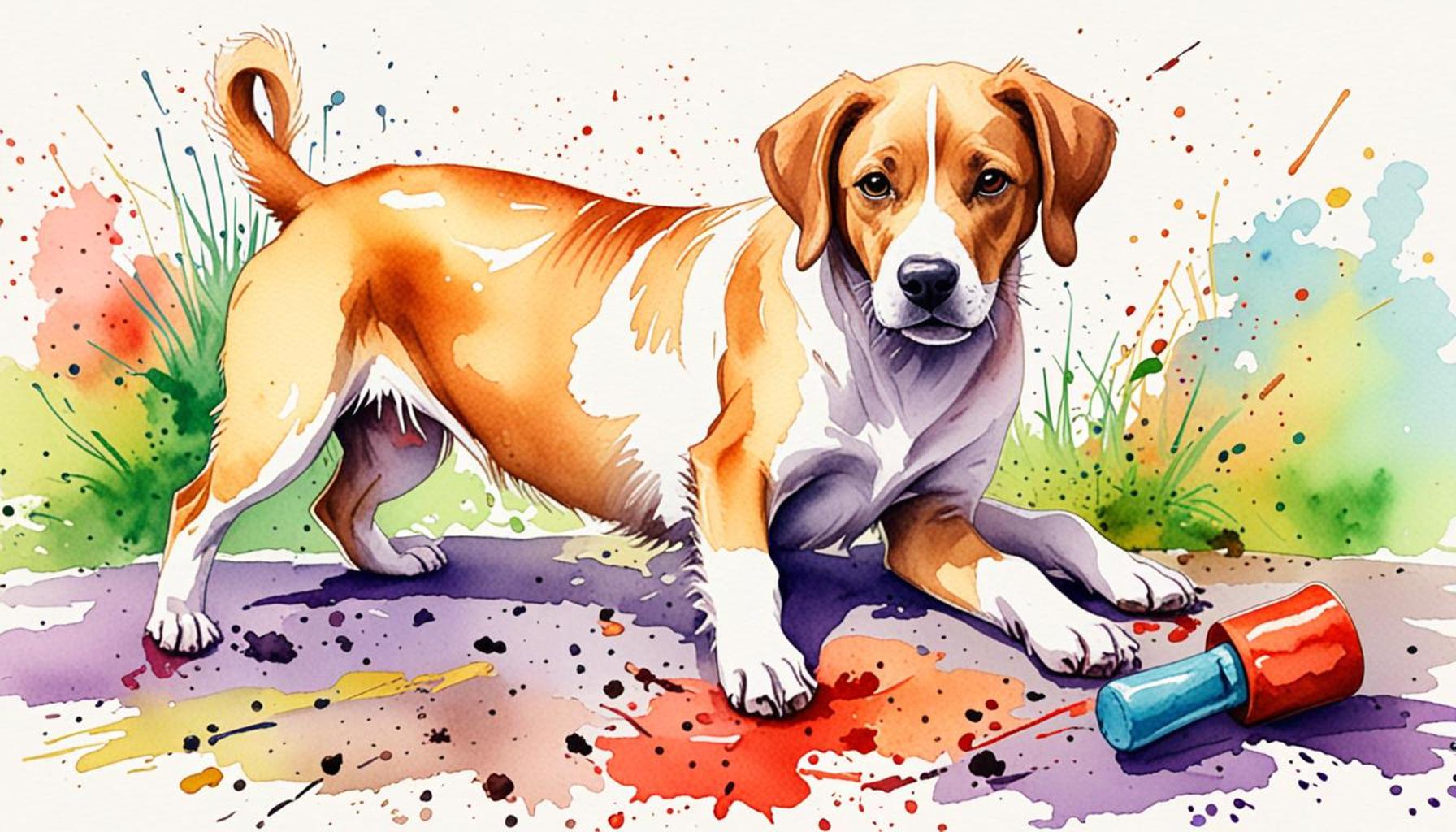Why Do Dogs Scratch the Ground? Exploring Instinctive Behaviors in Pet Dogs

The Mystique of Scratching: What It Tells Us About Dogs
Watching your dog intently scratch at the ground may leave you pondering what drives this seemingly simple behavior. While it often brings a smile to our faces, the reality is that scratching is far more significant than it appears on the surface. This instinctive action can be traced back to the dog’s wild ancestry and is deeply rooted in their natural instincts and behaviors.
Territorial Marking
Territorial marking is one of the foremost reasons behind a dog’s scratching behavior. Dogs are equipped with scent glands located in their paws, and when they scratch, these glands release scents that help them communicate their presence and claim a specific area as their territory. This is similar to how wild canines, like wolves, would establish boundaries within their pack territory, ensuring other animals are aware of their domain. For instance, a dog may dig around a tree or in the grass to leave its scent, effectively making a claim that signifies the spot as theirs. This behavior is particularly prevalent in areas that are frequented by other animals, where the need to assert dominance or ownership becomes paramount.
Foraging Behavior
Another fascinating aspect of this behavior is rooted in foraging instincts. Many dogs scratch as if they are instinctively searching for food. This mimicry of their wild ancestors, who would scratch the ground to unearth hidden food sources or roots, demonstrates a deep-set instinct that has persisted despite domestication. For example, a terrier may scratch at the soil, reminiscent of its hunting lineage, showcasing a natural drive to chase after small animals or find hidden treats. This behavior not only provides mental stimulation but also taps into their foraging skills, which can be especially entertaining for both the dog and its owner.
Creating Comfort and Safety
In addition to marking territory and searching for food, scratches serve practical purposes related to creating comfort and safety. Dogs may scratch at a specific area to flatten grass, dirt, or bedding, mimicking the way their wild counterparts would prepare a den for rest or safety. In your own backyard, a dog might scratch at a spot under a tree or a shaded area to create a cozy nook for themselves, demonstrating their instinctual need for a secure resting space. This action not only enhances their comfort but also provides a sense of well-being that resonates deeply with their instincts.
Understanding these behaviors is crucial for dog owners in the United States, where the diversity of dog breeds can lead to varying scratching habits. While some breeds may engage in scratching as a more pronounced expression of their instincts, others may do it occasionally or in specific contexts. Thus, appreciating the nuances of these behaviors can deepen your bond with your pet and improve your ability to meet their needs.

By examining the reasons behind your dog’s scratching behavior, you can unlock a treasure trove of understanding about their instincts and preferences. The next time your dog decides to scratch, remember that this captivating action carries a wealth of meaning, connecting them to their ancestors and the natural world.
FIND OUT MORE: Click here to learn about your cat’s natural instincts
Unpacking the Scratch: Understanding Your Dog’s Behavior
Many dog owners might find themselves awestruck by how often their furry companions seem to engage in scratching. While it’s easy to dismiss this action as mere playfulness or a quirky habit, it is, in fact, a behavior steeped in primal instincts that reveal much about the psyche of dogs. Beyond the surface-level amusement, scratching serves key roles that hark back to a dog’s wild ancestry.
Emotional Expression and Stress Relief
Dogs are highly sensitive creatures, and their scratching can also reflect their emotional state. Just like humans may fidget or tap their feet when nervous or anxious, dogs may scratch as a coping mechanism. This behavior can be indicative of stress, excitement, or even frustration. For instance, a dog might scratch before or after a big event, like a visit to the vet or a session at the dog park, as a way to relieve their pent-up energy. Observing your dog’s environment can give helpful clues; numerous dogs scratch noticeably when they’re in unfamiliar settings or engaging with new people or animals. Recognizing this behavior as an emotional outlet is vital for providing the support necessary to keep your pup calm and comfortable.
The Playful Side of Scratching
Additionally, dogs often scratch the ground out of sheer joy and playfulness. This behavior can be especially pronounced in younger dogs and certain breeds known for their exuberance. When they simultaneously run, jump, and scratch, it’s a demonstration of their playful spirit, showcasing their zest for life. Many dogs will scratch at the ground in a playful manner as they toy with their surroundings or interact with their humans during games like fetch. Understanding this playful aspect enables owners to engage their pets in activities that satisfy this need for movement and interaction.
Factors Influencing Scratching Behavior
Several variables affect why and how often dogs scratch the ground:
- Breed Characteristics: Some breeds are more prone to scratching behaviors, particularly those with a stronger hunting or foraging instinct.
- Environment: A dog’s surroundings, such as the presence of other animals or unfamiliar territories, can incentivize increased scratching.
- Age: Younger dogs, particularly puppies, may scratch more frequently during their exploration phase as they learn about their world.
- Health Status: In certain cases, excessive scratching could signify underlying health issues such as allergies or skin irritations, necessitating a consultation with a veterinarian.
By delving into these factors, dog owners in the United States can better understand their pets’ behaviors and the motivations behind them. This understanding fosters a deeper connection with their canine friends and equips them to provide an enriching environment that considers their pets’ natural instincts and needs.
As we unravel the complexities behind your dog’s scratching behavior, a rich tapestry of ancestral wisdom, emotional expression, and play unfolds. Observing these elements can lead to enhanced interactions, deeper empathy, and a healthy outlet for your dog’s intrinsic urges.
Understanding the Behaviors Behind Ground Scratching
When observing our furry friends, it’s common to notice various peculiar behaviors, one of which is scratching the ground. This seemingly odd action is deeply rooted in instinctive behaviors that date back to their wild ancestors. Dogs scratch the ground for multiple reasons, ranging from territorial marking to nesting instincts.
Territorial Marking
Ground scratching is often a way for dogs to communicate and establish their territory. By using their paws, dogs can displace dirt and debris, leaving their scent behind. The scent glands located in their paws play a vital role in this behavior, signaling to other animals that the area is claimed. This instinct to mark territory is not only prevalent in canines but also observed in various other species. Understanding this behavior provides insights into how dogs perceive their environment and interact with other animals.
Nesting Behavior
Additionally, dogs may scratch at the ground as a way of creating a comfortable nest. In the wild, ancestors of domestic dogs would scratch at the ground to create a safe and secure area for resting or giving birth. This instinctual behavior can manifest in our pet dogs when they are trying to find a cozy spot to settle down. It is a behavior that can be observed more prominently in pregnant dogs or those undergoing hormonal changes.
Searching for Temperature Regulation
Another factor to consider is temperature regulation. By scratching the ground, dogs may be seeking cooler soil on hot days or digging at the surface to find warmth during colder months. This behavior reflects their natural instincts to adapt and survive in their surroundings, showing their innate ability to respond to environmental changes.In conclusion, understanding why dogs scratch the ground reveals a fascinating glimpse into the instinctive behaviors that define our beloved pets. By addressing these natural tendencies, pet owners can foster a deeper connection with their dogs, mitigating unwanted behaviors through constructive outlets.
| Instinctual Behavior | Description |
|---|---|
| Territorial Marking | Dogs use their paws to leave scents that identify their territory. |
| Nesting Instinct | Scratching creates a safe spot for resting or birthing, reminiscent of wild behaviors. |
| Temperature Regulation | Dogs dig to find cooler or warmer ground, adjusting to environmental changes. |
By exploring these instinctual behaviors, we gain valuable knowledge about our dogs’ needs and tendencies, enhancing our ability to care for them effectively.
DISCOVER MORE: Click here to find local animal shelters and adoption organizations
Decoding the Scratch: The Social Dynamics of Canine Behavior
As we peer deeper into the reasons your dog might engage in scratching, we uncover another layer of this instinctive behavior based on social dynamics and communication. Dogs, being naturally social creatures, often scratch in ways that reflect their interactions with their environment, their pack, and even other animals.
Social Communication and Territory Marking
In the wild, dogs used scratching as a form of communication, especially for marking territory. They would dig or scratch the ground to leave behind scent markers through glands in their paws and in their urine. This behavior transcends the singular act of scratching; it becomes an essential tool for social interactions. When a dog scratches the ground, it can be signaling to other dogs that this area is claimed or used, indicating status and presence. This behavior can be particularly noticeable in multi-dog households or parks where various dogs turn up. Spotting your dog scratching frequently in these scenarios may signal their effort to establish their presence among the canine community.
Instinctual Foraging Behavior
Another significant factor linked to ground scratching is a dog’s instinctual foraging behavior. In their ancestral days, dogs relied on their ability to hunt and gather food; thus, scratching could represent a dog’s natural attempt to dig for potential snacks hidden beneath the surface, such as insects, rodents, or even edible plants. While domesticated dogs are less likely to execute successful hunts, they still display this ancient instinct through scratching. Owners may find that their dogs scratch especially in areas where they detect interesting scents or with the potential for hidden treasures. Providing dogs with foraging toys or interactive food puzzles can channel this instinctive behavior positively and constructively.
Field Instincts and Training Opportunities
Trainers and behaviorists suggest that recognizing your dog’s instinctual behaviors opens doors for engaging training opportunities that can enrich your dog’s physical and mental health. Redirecting your dog’s scratching towards acceptable and constructive activities can improve their behavior and offer satisfaction. For example, if your dog is scratching intensely at a specific spot in your yard, consider introducing agility exercises, scavenger hunts, or obedience training that incorporates similar movements. This strategic redirection can not only curb unwanted scratching but also promote physical activity, socialization, and mental stimulation.
Environmental Enrichment and Lifestyle Considerations
Moreover, the scratching behavior can also be linked to environmental enrichment. A dog living in a stimulating and interactive environment is less likely to engage in excessive scratching. Offering toys, puzzles, and social playtime taps into their natural instincts and reduces the occurrence of behaviors driven by boredom. Additionally, ensuring a secure and engaging atmosphere—whether it be through providing various surfaces in your yard, allowing exploration in a safe area, or arranging supervised playdates—can help balance a dog’s instinctual needs.
As we explore these various dimensions of scratching behavior, it becomes evident that it is not merely an eccentric habit but a reflection of deep-rooted instincts and adaptive behaviors shaped by both biology and environment. This understanding equips pet owners with the knowledge to foster a healthier, happier life for their dogs, respecting their natural tendencies while helping them thrive in a home setting.
DON’T MISS: Click here to ensure your pets’ safety and comfort
Understanding Your Dog: The Importance of Addressing Scratching Behaviors
In conclusion, the behavior of scratching in dogs is a fascinating blend of instinctual actions and social communication. By examining why our dogs scratch the ground, we uncover a world rooted in their ancestral behaviors that still holds significance today. The instincts that drive this behavior—such as territory marking, foraging, and social interaction—reveal how deeply connected our pets are to their wild ancestry, and how these elements intertwine with their domesticated lives.
Understanding the reasons behind scratching not only fosters greater empathy and patience in pet ownership but also encourages us to create environments that cater to these natural behaviors. For example, by providing mental stimulation through enrichment activities or managing a safe and engaging living space, we can help to minimize unwanted scratching while enhancing our pets’ well-being. With knowledge comes power; as pet owners, we have the ability to channel these instinctual behaviors in a constructive manner, aligning them with our dog’s needs and lifestyle.
As we continue to explore the evolutionary roots and psychological dimensions of our pets, we pave the way for richer relationships with them. Therefore, the next time you witness your dog scratching the ground, remember that it is not just a quirky habit but a vivid expression of their canine identity. Encouraging this behavior properly can lead to a happier, healthier dog, and ultimately, a more harmonious household.



